It is not possible to keep this blog completely up to date when we are travelling. Some evenings we are just so exhausted with sightseeing, taking in new experiences and searching for somewhere to sleep at night that we just want enjoy a glass of wine – we brought a large container with us from Ambre – to cook supper and fall asleep. Some nights we don’t even have access to electricity so cannot use our computer.
Last night we went across to the bar on the campsite to see what Brits do in Spain over the winter. Those on the site at Estartit appear to be regulars and know the bar staff and their fellow caravaners. There was much rejoicing, hugging and kissing when friends from previous years arrived, drinks all round and even the barman joined in with the celebrations. We felt a bit self-conscious and very outside of a definite clique as we sat in our corner with our Spanish beers (which are great by the way) and later slunk away, back to Modestine, as soon as we politely could.
We decided to spend the day locally yesterday because we woke to glorious sunshine and had no idea of the area surrounding our campsite, having selected it as the only one for 50 kilometres around that is open during January! It turned out to be delightfully situated on the low plain of Emporda, less than a kilometre from the sea with the nature reserve islands of Les Medes just off-shore. Our bikes, Hinge and Bracket, have been rather inactive members of our team during the winter months, but we decided to let them out for the day and headed off down to the beach along lovely quiet roads with orchard trees and farmland on either side. Our first view of the coast was stunning with the sea a wonderful deep turquoise breaking in white spray on the clean empty sandy beach with the green islands of Les Medes a kilometre out to sea.
 The islands of Les Medes
The islands of Les MedesWe cycled along the empty beach to the village where it was market day with stalls out under the palm trees in the village square. Here we bought our vegetables along with the local people – tangerines still with their green leaves and stalks and fresh Spanish tomatoes and courgettes. We even saw cherries for sale – in January!
The village seems a pleasant place with wonderfully clean, wide streets and very little traffic. We felt completely safe crossing roads and strolling along the pavements – quite a new experience after southern France.
 The village church, Estartit
The village church, EstartitAt the further end of the village we stopped at a seafront café for coffee on the terrace overlooking the marina and relaxed in sunshine so warm and bright we actually felt hot! This was heaven after the cold of the previous weeks! Then we heard English being spoken around us. Well, maybe some Brits have a lot of sense! We don’t think it would be for us long-term and in the summer far too hot, but with Girona airport just a few miles away and flights at £20 return its appeal is obvious!
After a cycle around the harbour and a brief play on the beach we peddled back to Modestine for lunch.
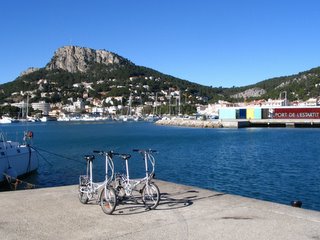 Hinge and Bracket go to the seaside, Estartit
Hinge and Bracket go to the seaside, Estartit On yer bike, Estartit
On yer bike, EstartitDuring the afternoon, although it remained warm, a strong wind blew up. This is known as the Tramontana and whilst it is very strong, it is not particularly cold. So during the afternoon we explored the local protected wetlands – reed beds and lagoons behind the beach, a haven to wild birds and plants. There are cycle tracks to be followed through the reeds out to the estuary of the little river Ter as it meets the sea.
 The Ter estuary, Estartit
The Ter estuary, EstartitThen we cycled back inland through orchards and meadows, interspersed with farms and with the snowy mountains of the Pyrenees, this time from the Spanish side, as a backdrop, to the little town of Torroella de Montgrí some 8 kilometres back from the sea. Unfortunately by the time we arrived we had little time to explore if we were to return to Modestine before dark, but we did manage a visit to the lovely old church and the historic quarter with its straight paved alleyways between the old house and its central arcaded square. Wherever a space could be found there were shrubs, cypress trees and grassy corners. It really was a pleasant little town.
 The church and Palau del Mirador, Torroella de Montgrí
The church and Palau del Mirador, Torroella de MontgríWe returned to Modestine just as darkness fell, exhausted from cycling into the wind for most of the afternoon.
Today we made the effort to get ourselves up and organised, so by 10.30 we were in Girona (or Gerona). This is a really delightful city with nothing at all to jar. We parked in gardens beside the river Onyar and walked into the old, partially pedestrianised centre with its cobbled streets and many flights of steps up to the Cathedral and the lovely sunny gardens with their palm trees and flowering shrubs just above the town. Down below the main streets are arcaded to give protection against summer’s heat.
The old town still retains much of its old walls and climbs up steeply in places from the river. As a result there are impressive flights of steps up to the main churches. The gothic church of Sant Feliu, (Saint Felix) with its truncated spire includes eight fourth century sarcophagi, now built into the walls of the church. As it is 1700 years since the martyrdom of Sant Felix they were given great prominence this year. Some have Christian motifs, others are still decidedly pagan in inspiration.
 4th century sarcophagus, St. Feliu, Girona
4th century sarcophagus, St. Feliu, GironaThe cathedral, reached up a flight of ninety steps, has a baroque façade which hides the widest gothic nave in Europe. After it was started there was a site meeting of architects in 1386 to decide whether it was practical to continue in this scale. A clever statue in the city commemorates the 600th anniversary of this meeting. The peaceful cloisters survive from the Romanesque cathedral, complete with beautifully detailed carvings of biblical scenes on the capitals – no iconoclasts to hack them about here and the Moors were safely expelled from this area. The chapter house contains a remarkable treasury including 9th century papal bulls written on papyrus, the Bible of Charles V of France and a remarkable 10th century embroidery of the creation.
 Baroque façade of the cathedral, Girona
Baroque façade of the cathedral, Girona Gothic nave and south door of the cathedral, Girona
Gothic nave and south door of the cathedral, Girona Monument to a mediaeval brainstorming session, Girona
Monument to a mediaeval brainstorming session, GironaBehind the Cathedral the areas around the city walls are landscaped into a series of labyrinthine gardens with steps, terraces and crumbling walls lending a most romantic atmosphere. There is even a Jardin John Lennon – why we have no idea. Next to the gardens the beautiful Romanesque church of Sant Pere de Gallignats is now an archaeological museum. The arcades, squares, promenades and arched loggias provide perspectives that recall Renaissance views of the ideal city, but there is a more intimate side in the narrow cobbled streets and the old houses overhanging the river.
 Sant Pere de Gallignats, Girona
Sant Pere de Gallignats, Girona Old houses overhanging the river, Girona
Old houses overhanging the river, GironaWe left Girona reluctantly, there is never enough time on these short winter days, and headed along the busy N11 to Blanes, built up along the sea front. We found the campsite as darkness fell. It is a 20 minute walk along the seafront from the town centre which tonight was buzzing with activity as we wandered around the brightly-lit streets. Children were out enjoying the slides in the playground and chasing each other in the darkness while their parents stood in groups chatting. Life is lived very much more on the street in Spain than it is in France or Britain. Tonight on this campsite there is laughter and lights as people gather together nearby for a barbecue and the weather is really mild, even at 10pm.
Saturday 21st January 2006, Blanes, Catalonia
The sun was shining again this morning as we left Modestine to rest peacefully on the campsite and walked across town to find the railway station. It turned out to be a lot further than we expected and along several unpleasantly busy roads without footpaths.
Trains from here to Barcelona are very regular and take just over an hour, travelling along the seafront, stopping at every little town as they go. The view towards the Mediterranean is wonderful for almost the entire journey with endless empty sandy beaches, juniper pines, deep blue sea and gentle white waves. Sometimes there are campsites amongst the pines bordering the beaches and low level holiday accommodation but nothing unpleasant. On the other side of the railway track however, there is much industrial and commercial development and it is really quite ugly. Travelling by road, this is all you would see of the coastline.
We realised we would never be able to do justice to Barcelona in a day, but at least we would get a taste of what it has to offer and going by train meant a lot less worry and hassle than driving.
On approaching the city the train becomes an underground. So we were disgorged into the heart of the city at Plaça de Catalunya at the top of the famous Rambla – a wide, very crowded pedestrianised avenue leading down a kilometre into the city, lined on either side by flower stalls and entertainment artists – living statues being particularly popular. Here “Castro” would stand motionless until given some money, when he would salute and disclaim loudly, stopping abruptly until someone gave him another euro! Next to him a silver “skeleton” would peddle frantically on his bike for a few cents, and the invisible man further down the Rambla would shake hands with you! All great fun and appreciated by onlookers.
 Strolling in the Rambla, Barcelona
Strolling in the Rambla, Barcelona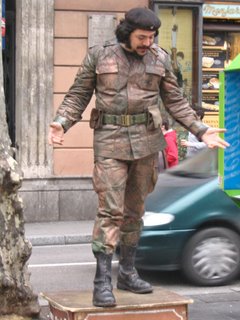 Fidel Casto rejuvenated, Barcelona
Fidel Casto rejuvenated, BarcelonaWe looked in at the main market, huge and crowded, filled with every kind of fruit and vegetable imaginable – chestnuts, strawberries, cherries and mangostines for sale on the same stall. There were stalls selling dried fruits, nuts, herbs and spices. The fish market was seething with people buying octopus, clams and fish for the weekend meal. The meat market too was a buzz of activity with the butchers wielding their cleavers with terrifying dexterity.
 Mercat de la Boqueria, Barcelona
Mercat de la Boqueria, Barcelona Mercat de la Boqueria, Barcelona
Mercat de la Boqueria, BarcelonaWe spent the entire day walking around the city, exploring around the cathedral, swathed in scaffolding and with a jazz band playing near the main entrance, and the Sagrada Familia, a strange church built in the 1880s but much altered since with weird additions in the form of modernist turrets topped with fruits, and heavy, powerful and rather unpleasant statues on the façade.
 Outside the cathedral, Barcelona
Outside the cathedral, Barcelona Sagrada Familia, Barcelona
Sagrada Familia, Barcelona Façade of the Sagrada Familia, Barcelona
Façade of the Sagrada Familia, BarcelonaOur wanderings took us past the Picasso museum, housed in two gothic palaces and has a pleasant courtyard with citrus fruits. We are not Picasso groupies and having already seen a number of his works on a previous visit to Spain we did not waste our precious hours and euros to be hoodwinked further. In any case, we were able to “appreciate” one of his works on the side of the Barcelona’s college of architects. The local playgroup would probably have done just as good a job and charged considerably less for it.
 Collegi d’Arquitectes with frieze by Picasso, Barcelona
Collegi d’Arquitectes with frieze by Picasso, Barcelona The packaging better than the contents perhaps, Picasso museum, Barcelona
The packaging better than the contents perhaps, Picasso museum, BarcelonaOur ramblings took us across the city past the zoological museum, a neogothic pavilion built for the 1888 World Fair, with its pleasant public gardens, and along through the Triumphal Arch constructed for the same event.
 Arc de Triomf, Barcelona
Arc de Triomf, BarcelonaAmongst the unexpected joys of the day were the chance discoveries of two wonderful exhibitions, each of which would have justified a special visit of their own. Both were free! The first was at the National Library of Catalonia and celebrated 400 years since the publication of Cervantes Don Quixote. Exhibits were entirely from volumes held in the library’s own collections and included translations and first editions from around the world as well as editions illustrated by artists such as Gustave Doré and early copies of works such as Amadis de Gaul which had inspired the errant knight. A truly stunning exhibition.
 Courtyard with orange trees at the National Library of Catalonia, Barcelona
Courtyard with orange trees at the National Library of Catalonia, Barcelona Don Quixote exhibition in the National Library of Catalonia, Barcelona
Don Quixote exhibition in the National Library of Catalonia, BarcelonaThe second was a huge Rembrandt exhibition, primary from the collections of the Bibliothèque Nationale de France and on loan to Barcelona. This exhibition was devoted entirely to Rembrandt’s etchings and again it was free of charge! The joy of such an exhibition was that prints taken from different states of the copperplates could be displayed so it was possible to see how the final work was developed. It was also surprising to realise how many copies of each state the artist produced and we wondered what the market for unfinished prints must have been back in the 17th century.
This exhibition was held in the Casa Milà, one of the major examples of Modernist architecture, a huge extravagant building of around 1900 on the Passeig de Gràcia. Similar buildings lined the street, each attempting to outdo its neighbour, producing a really exciting street façade where even the lamp posts are ornate, curved structures in wrought-iron.
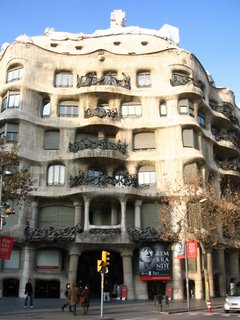 Casa Milà, Barcelona
Casa Milà, Barcelona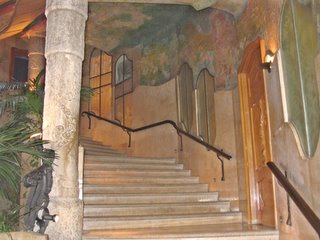 Interior of the Casa Milà, Barcelona
Interior of the Casa Milà, Barcelona Casa Batlló, Barcelona
Casa Batlló, Barcelona Typical modernist architecture, Barcelona
Typical modernist architecture, Barcelona Building on the Passeig de Gràcia, Barcelona
Building on the Passeig de Gràcia, BarcelonaFinally we searched out – with great difficulty as the map was unclear, but Ian’s self esteem was rapidly plummeting as he convinced himself he was stupid not being able to find such an important site – the Palau de la Mùsica Catalana. Fortunately we located it before he became a quivering heap in the gutter and it was certainly worth the effort though, being in a side street, the extravagance of its façade could not be seem to full advantage. Inside there was a feel of Art Nouveau elegance with coloured glass, mirrors, lamps and dark wood panelling. Concerts are held here regularly. It would be a wonderful and elegant experience to attend one. The entire complex of modernist architecture in Barcelona is listed as another of Unesco’s world heritage sites.
 Palau de la Mùsica Catalana, Barcelona
Palau de la Mùsica Catalana, BarcelonaExhausted by so much in such a short time, and having been walking the entire day we slumped down in a nearby bar with beers and tapas and simply enjoyed feeling wearily happy after a day that we can never do justice to in this brief description. Finally, around 7pm we limped, sore foot back to the station, the bright dazzling lights tempting us to linger to experience the different face of the city’s night-life. The train journey back was spent half asleep. We limped out of the station to find a welcoming yellow town bus to meet the train. It was only when it turned off in the direction of Lloret de Mar rather than the centre of Blanes, we realised we had got on the wrong one and were being driven in the opposite direction from our campsite and Modestine! So we got off and walked, or rather hobbled, the three kilometres back through the town and out the other side. Rarely have we been more grateful to find Modestine patiently waiting for us and to turn on the fire and warm up with hot mugs of tea after our chilly walk along the seafront!
Sunday 22nd January 2006, Blanes, Catalonia
Unbelievable as it may seem, we are sitting in the sunshine outside of Modestine to write today’s blog!
Blanes has a designated “cultural site of national interest” just a couple of kilometres from here, so this morning we walked along the deserted sea front with its blocks of holiday apartments, past the town and the harbour with its pleasure boats, past the seafront cafés and restaurants and finally up the steep twisting hill at the further end of the town where the wonderful botanic gardens of Marimurtra are to be found. The climb up gave lovely bright views back over the town and the glittering bay and there was real warmth in the sunshine.
 Local birdlife, Blanes
Local birdlife, Blanes View onto the harbour at Blanes
View onto the harbour at BlanesThe gardens turned out to be as wonderful as we had hoped, and on a Sunday morning we had them entirely to ourselves. It took us a couple of hours wandering from one stunning vista to the next, following raked sandy paths or red tiled pathways and flights of steps through botanical collections from the Mediterranean, the Canaries, Chile and Argentina, as well as Australia and elsewhere. Constructed on the steep hillside, the gardens showed the plants to full advantage with huge cactuses, palm trees, aloes, flowering succulents, rosemary, lavender and thyme. There were small ponds, pergolas and terraces offering magnificent views along the rocky coastline away from the town, with bright flowers blooming right down to the sea. There were avenues of citrus trees, hanging with oranges and lemons. There were shrubs bright with flowers, fig and olive trees, hottentot figs and date trees. Already it is impossible to recall all the different plants we have seen and anyway we don’t know the names of many of them. It seemed strange to recognise so many from our garden in Exeter, but here they are ten times bigger and usually full of fruit or flowers. If it is this beautiful in January, what will it be like in a few weeks when the masses of succulents covering the rocks burst into cascades of red, purple, pink and yellow flowers?
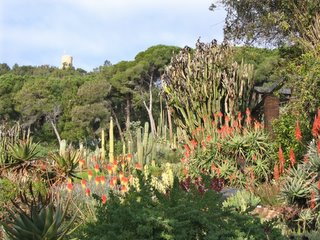 Jardí Botanic Marimurtra, Blanes
Jardí Botanic Marimurtra, Blanes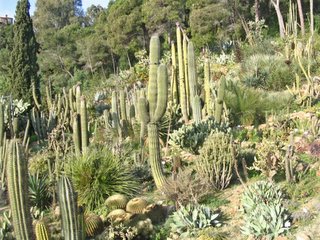 Jardí Botanic Marimurtra, Blanes
Jardí Botanic Marimurtra, Blanes View towards Lloret de Mar from the Jardí Botanic Marimurtra, Blanes
View towards Lloret de Mar from the Jardí Botanic Marimurtra, Blanes Temple of Linnaeus in the Jardí Botanic Marimurtra, Blanes
Temple of Linnaeus in the Jardí Botanic Marimurtra, Blanes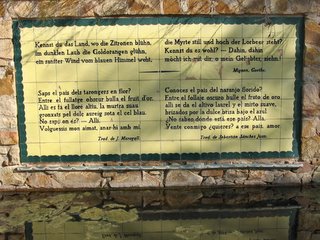 Poem by Goethe translated into Catalan and Castilian in the Jardí Botanic Marimurtra, Blanes
Poem by Goethe translated into Catalan and Castilian in the Jardí Botanic Marimurtra, BlanesYou know the country where the lemon grows
And dark-leaved the golden orange glows
Softly a wind blows from the clear blue sky
Through myrtle silent and through laurel high
You know it well - away, away,
There would I go with you my love today.
(Ian’s translation from Goethe)
 View from the Jardí Botanic Marimurtra, Blanes
View from the Jardí Botanic Marimurtra, Blanes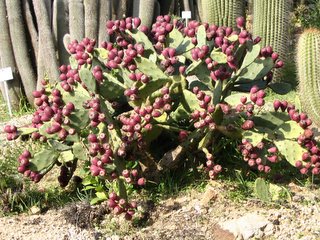 A particularly productive prickly pear, Jardí Botanic Marimurtra, Blanes
A particularly productive prickly pear, Jardí Botanic Marimurtra, BlanesLovely as it was having the place to ourselves, it seems such a pity that people around the world living in cold or crowded towns and cities are unable to enjoy this with us and the local people simply accept it, leaving it generally unnoticed.
By the time we left it was well after midday and as we descended into the town we could hear a band playing on the sunny seafront. It was the Sunday lunchtime paseo and the entire town was out, dressed in their best, walking up and down the esplanade, greeting each other with a cheerful “hola”. There were seafront roundabouts, swings and slides. Many cafés and bars were open and everywhere tables were full of family groups enjoying beers and tapas. Children played on the sandy beach, any dogs that were around (not many) were all well behaved on leads and around the bandstand a crowd had gathered to watch as people spontaneously joined together, holding hands in circles to dance the sardana, a dance typical of Catalonia.
 Local people enjoying Sunday lunchtime in Blanes
Local people enjoying Sunday lunchtime in BlanesSuch joy and pleasure in a sunny Sunday is infectious. We watched the dancers and listened to the band, specially invited from Cadaqués to play here today. Later we sat at a table by the beach and enjoyed chilled Spanish beer and a dish of olives stuffed with anchovies while the waiter informed us that he was glad we were English as his wife is English too and wished us a wonderful stay in Catalonia.
And so we have returned to Modestine for a late lunch and to write a few postcards. The campsite too is busy with lots of families arrived from Barcelona for the weekend, busy having family meals together outside their caravans or chalets. The Spanish seem very noisy, but happy people and there is the permanent sound of cheerful chatter and laughter.
